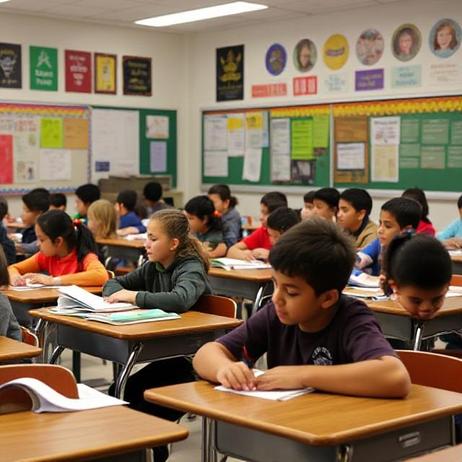Public School Funding 2025: What Families Should Know
Navigating public school funding in 2025 can feel daunting for families, students, and educators alike. Understanding how funding is generated, allocated, and spent at the local and national level can empower you to ask the right questions, advocate for your school, and make informed decisions. This article explains how public school funding works in 2025, what changes are under way, and how families can engage meaningfully.
How Public School Funding Works
Major funding sources
Public school funding in the United States comes from three primary sources: local taxes, state revenues, and federal funds. These combine to support K-12 public schools across districts.
Local funding usually comes from property taxes, local levies, and sometimes local sales taxes.
State funding comes from state education budgets and formulas that allocate funds across districts.
Federal funding contributes a smaller but often critical portion—on average about 8 to 10 % of K-12 funding nationally.
Why the federal share matters
Even though federal funding is a relatively small portion, many of the federal programs target high-need students, special education, English learners, and after-school programs. That means that for many school districts what happens at the federal level has outsized impacts.
The basic flow
Congress and federal agencies appropriate funds.
Federal programs (such as Title I, Title II, Title III under the Elementary and Secondary Education Act) send funds to states.
States distribute to districts according to formulas or grants.
Local districts allocate to individual schools, based on enrollment, special-needs status, programs, and other factors.
Schools use funds for teacher salaries, support services, facilities, technology, special education, etc.
What’s New in 2025
Federal developments
The U.S. Department of Education’s budget summary for fiscal year 2025 emphasises investments in evidence-based strategies, mental health supports, multilingual programs, and workforce development.
A recent survey shows that more than three-quarters of district leaders expect federal funding for K-12 education to either stay flat or decline in coming years.
The funding pause and grant review triggered by administration decisions in mid-2025 create uncertainty for many districts.
State and local shifts
Some states have introduced changes to their funding formulas (for example shifting metrics for eligibility or adjusting per-pupil amounts).
Local districts face enrollment declines and rising costs (inflation, labor, special education) which squeeze budgets even when revenues are stable.
Families and educators should ask: “How much money per student is my district getting? What is new in this year’s budget?”
What these developments mean
Budgeting uncertainty means districts may delay new programs, hold off on staffing increases, or reduce non-core services.
Schools with higher shares of federal funding (e.g., those serving more low-income students, English learners) may face disproportionate impact.
While local and state dollars remain the mainstay, federal fluctuations affect equity initiatives, after-school programs, summer learning, and teacher-support grants.
What Families Should Know and Ask
Key questions to ask your district or school
What is the per-pupil funding in my district and how has it changed this year?
What percent of our budget comes from state vs. local vs. federal sources?
Has there been any change in federal funding streams (e.g., Title I, Title III, IDEA) for our school?
How does the school allocate funds for extra support (tutoring, English learners, special education)?
What programs are contingent on federal or grant funding and therefore might be at risk if funding falls?
Family tips
Stay informed about the budget calendar in your district. Many funding decisions are made well before the school year begins.
Engage with parent-teacher associations or school budget committees; ask for clear breakdowns.
If your school has a significant population of English learners, special education students, or low-income families, pay particular attention to federal funds designated for these groups.
Watch for local ballot measures, levies, and referendums that may affect the local share of school funding.
Quick Comparison Table: Funding Streams
| Funding Source | Typical Share of Total Funding | Primary Uses | What to Watch in 2025 |
|---|---|---|---|
| Local (property tax, levies) | ~40-50 % (varies by state) | General operations, teacher salaries, facilities | Changes in property tax base, local levies |
| State funding | ~40-50 % (varies widely) | Equalisation among districts, state programs | Budget shortfalls or formula changes |
| Federal funding | ~8-10 % nationally | High-need student supports, federal grants | Delays in release, changes in eligibility |
Note: Percentages vary significantly by state and district; schools with high poverty or English learner populations may have larger federal shares.
Why This Matters for Students and Families
Program continuity: Schools rely on predictable funding to maintain tutoring, summer learning, and support staff. When funding is uncertain, these support services are often the first affected.
Equity implications: Because federal funds often target vulnerable students, reductions or delays can widen gaps in access, readiness, and outcomes.
Transparency and accountability: When families understand how funding flows and where it goes, they are better positioned to advocate for fair allocations, ask the right questions, and support school decisions.
Local context matters: While the national picture is important, the impact in your community depends on state budget decisions, local tax bases, district enrollment trends, and how the school allocates resources.
What to Watch Going Forward into 2026 and Beyond
Proposed federal budgets for 2026 have included significant cuts or restructuring of K-12 grants and formula programs.
Districts are increasingly modelling plans that assume somewhat lower federal funding rather than assuming flat or rising amounts.
At the state level, budget stress (from economic shifts, enrollment declines, inflation) could push states to revisit public school funding formulas, potentially impacting per-pupil spending.
Local ballot measures and property tax levies may become more important as districts rely on local resources to fill gaps.
Schools serving high-need populations should monitor appeals and communications around federal grant eligibility, release dates, and carry-over flexibility.
Final Thoughts
For families, students, and educators, understanding public school funding in 2025 is more than academic. It represents the resources available for teachers, programs, facilities and supports that directly affect the educational experience. While the big picture shows federal, state and local sources interacting, the most meaningful impact happens at the district and school level—and that is where engagement, questions and advocacy matter.
By asking the right questions, keeping an eye on funding developments, and participating in local budget discussions, families can help ensure that resources flow where they are most needed. In 2025 and beyond, funding stability and transparency will be essential if public schools are to meet the needs of all students.
Disclaimer: This article is for informational purposes only and does not constitute financial or legal advice. Families and educators are encouraged to consult local district communications and state education agency documents for specific figures and details.













